 Research Article
Research Article
Investigation of the Human Diet in Pella (North Greece) from the Prehistoric to the Classical Period Using Stable Isotopes and Radiocarbon Dating
M Maniati1, Th Pitsios2 and Y Maniatis1*
*1Laboratory of Archaeometry, Institute of Nanoscience and Nanomaterials, Greece
2Anthropological Museum, Medical School, National and Kapodistrian University of Athens, Greece
Yannis Maniatis, Laboratory of Archaeometry, Institute of Nanoscience and Nanomaterials, NCSR Demokritos, 153 10 Aghia Paraskevi, Attiki, Greece.
Received Date: September 26, 2023; Published Date: November 01, 2023
Abstract
The skeletal material from the Classical and Prehistoric period cemeteries of ancient Pella in Central Macedonia, Greece was examined anthropologically and analyzed for the stable isotopes of carbon and nitrogen. Additionally, the Prehistoric cemetery burials were radiocarbon dated. The dates define the use of the prehistoric cemetery in the Early Bronze Age period (6600-6050 BC). The anthropological examination and isotopic analysis provided information on the sex, age at death, dental hygiene and gave interesting insights about the eating habits and access to food sources in the two periods. The people of the Classical period seem to consume much more foods enriched in animal protein (meat and dairy products) from the terrestrial environment as evidenced by the increase mainly in δ15N and not particularly δ13C, than the EBA people. A certain differentiation was observed in the diet between men and women in the EBA, with the diet of women being tentatively less enriched in animal proteins compared to that of men. No difference was observed in the Classical Period which may indicate and improvement in the socio-economic conditions.
Keywords: Ancient Pella; North Greece; Classical; EBA; Prehistoric; Cemetery; Burials; Anthropological examination; Stable isotope analysis; Diet; Radiocarbon dating
Introduction
The ancient city of Pella in Central Macedonia, Greece, was an important centre of civilization in the period from 400 to 168 BC. During that time, it was the Royal capital of the Macedonian Kingdom, which had been transferred from Aegae (Vergina). The city served as the seat of Philip II of Macedon, ruler of the unified Greek states, and father of Alexander the Great who reached the Siberian steppes, Hindus River and Egypt, and created the Hellenistic World. Pella is situated about 40Km northwest of Thessaloniki. Now located about 30 Km away from the nearest coast, but when established as the new capital (about 400 BC), it was a coastal city on the shores of Thermaikos Gulf. Gradually, the sediments of the Axios, Aliakmon and Loudia rivers reshaped the area, closing the bay and creating in this place a lake that was artificially dried up in 1930 in order to create cultivatiοn land. The Classical period city was established near the site of an earlier coastal settlement that flourished from the Bronze Age and until the new capital was established (Lilimbaki- Akamati et al. [1], Akamatis [2]). The excavations by Professor Yannis Akamatis and Maria Akamati of the Aristotle University of Thessaloniki and the Pella Archaeological Ephorate, brought to light a cemetery in the Agora district with all of its graves intact dating to the Classical period, from the late 5th to the third quarter of the 4th century BC (Akamatis [3]), and a second cemetery of prehistoric period located below the Hellenistic city of Pella (Aka matis [4]) that is most probably associated with an earlier Bronze Age settlement. The area therefore presents continuous occupation in different time periods which lend great interest in terms of the similarities/differences in the diet followed by the successive population groups.
Therefore, the two aforementioned cemeteries presented an interesting material for studying the diachronic human diet in the area. Anthropological examination and sampling of the skeletal material from both the prehistoric and classical period cemeteries was conducted. Furthermore, radiocarbon dating was performed in a series of bone samples from the prehistoric cemetery, whose age was unknown. The classical cemetery burials were not radiocarbon dated because their dating in the late 5th-early 4th c. BC is highly secured based on associated archaeological evidence (Akamatis [3]), and also because the radiocarbon dates have no precision in this time period due to well-known plateau in the calibration curve (Bronk Ramsey [5]).
The stable isotopes ratios of carbon 13C/12C and nitrogen 15N/14N in bone collagen are used to study a person’s diet and give information about the type of food they consumed during the last ten years of their life (Ambrose and Krigbaum [6]). The values of these isotopes normalized to the standard PDB (Pee Dee Belemnite) and expressed as δ13C and δ15Ν per mil (‰) reflect the protein part of the diet and can distinguish the consumption of terrestrial plants and animals from the marine environment ones (Van Der Merwe and Vogel [7], Howland et al. [8], Müldner and Richards [9]) or from a mixture of them. In addition, information for the consumption of various types of terrestrial plants such as C3, C4 and CAM can be also derived (Schoeninger and DeNiro [12]). These plan categories give different isotopic values because of the different photosynthetic pathways they follow. C3 plants are native to temperate regions (Europe, North America) and include all trees, shrubs and various grains. C4 plants are native to the tropics (Africa, South America) and include corn, sugarcane and various tropical grasses. In ancient Greece the only plant of the C4 category known to exist from the Bronze Age is millet which was probably used for animal feed (Valamoti [11], Petroutsa [14]). Its use became more systematic after the Early Iron Age (Triantaphyllou [15]). The CAM category includes plants that alternately use both photosynthetic pathways depending on environmental conditions. Some examples are pineapple, cactus and prickly pears.
Samples and Techniques
The skeletal material of Pella from the cemeteries of the Prehistoric and Classical period has been collected during archaeological excavations in the area of ancient Pella and are stored in the excavation storerooms at the archaeological site. Thirty (30) skeletons from individual burials were studied. Among the burials in the prehistoric cemetery, a burial was found whose skeleton belonged to the Byzantine period as it emerged from the radiocarbon dating.
Anthropological study: Sex and biological age were recorded, where there were informative skeletal features. Also, dental diseases (caries, calculus, periodontitis) were recorded in those skeletons with preserved jaws and teeth.
Radiocarbon Dating: Fifteen samples of bone were collected from different well-stratified burials in the prehistoric cemetery of Pella. In two cases where there were two burials in the same grave, samples were taken from both (upper and lower skeleton). The samples were processed at the radiocarbon unit of the Laboratory of Archaeometry, NCSR “Demokritos” which uses the Gas Proportional Counting technique (GPC). The spongy bone and any encrustations were removed with a lancet. The samples were then washed with deionised water and put in an ultrasonic bath to remove soil or dirt precipitations. This was followed by chemical treatment (Acid-Base-Acid) to extract the collagen and gelatinize it and then combustion to turn the samples into CO2. For the full treatment and measurement protocols used in the Laboratory see (Maniatis and Ziota 2011; Maniatis et al. [16]). The calibration of the radiocarbon dates was done with the program OxCal v.4.4.4 (Bronk Ramsey 2021).
Stable isotope analysis: Thirty bone samples were collected from different burials in both cemeteries. The bone samples were cleaned mechanically externally and internally removing the spongy substance of the bone which is more vulnerable to contamination from the burial environment. Then the samples were treated with 0.6N hydrochloric acid at a temperature of 4°C until the inorganic part was dissolved and the organic part (collagen) remained. A light treatment with potassium hydroxide (0.6N) was also applied to remove possible humic acids absorbed from the soil and then a brief treatment with 0.6N hydrochloric acid again. The samples were then transferred to an aqueous phase and a lyophilizer was used to dry the collagen. The now purified collagen was weighed to load the samples into the mass spectrometer (IRMS). Before introducing the samples into the mass spectrometer, the sample passed through an elemental analyzer where the total amount of carbon (C) and nitrogen (N) was measured.
Results and Discussion
Radiocarbon Dating
The radiocarbon results from the 15 dated bone samples are presented in Table 1. They come from different graves, except samples 1 & 2 and 3 & 4 that come from the same grave containing two skeletons one above the other (upper and lower). The radiocarbon age (BP) is shown as well as the calibrated age ranges for 1σ (probability 68.2%) and 2σ (probability 95.4%). Figure 1 shows the calibrated probability distributions ordered from older to younger BP age. Some dates have a rather large uncertainty because the amount of collagen extracted was small. As can be seen sample DEM-1972 gives a date in the historic period, which can be classed in the Byzantine/ Early Christian period and probably presents an intrusion grave in the prehistoric cemetery. Figure 2 shows the calibrated ages ranges of only the prehistoric dating samples. The samples from the same grave are plotted one after the other for comparison. The dots represent the weighted mean value of the calibrated age range. The expression “Sum” at the bottom of the plot represents the accumulated probability ranges for all the samples.
This is shown better in an expanded plot of the “sum” in Figure 3. From this plot it can be seen that the overall time of use of this cemetery ranges approximately from 2660 BC to 2050 BC. These dates define the use of the cemetery in the Early Bronze Age (EBA) and more particularly in the middle and lower part of it (Arvaniti and Maniatis [17]). They compare to the earlier part of the EBA/ MBA cemetery of Koilada-Xeropigado in West Macedonia (Maniatis and Ziota 2011). The Pella cemetery starts earlier (2600 BC) than the Koilada-Xeropigado (2400 BC), but it does not continue in the MBA as the latter. From the “sum” diagram (Fig. 3) it can also be seen that the period of most intense use of the cemetery is approximately 2500-2300 BC. Regarding the two burials in the same grave, the upper burial (7/21) seems to have occurred soon after the lower burial (7/20) (Table 1, Figure. 2). However, the upper burial in the other grave (7/37) seems to have occurred about 100 years later than the lower one (7/40) (Table 1 & Figure 2).
Table 1: Radiocarbon dating results of the Pella prehistoric cemetery burials (Pella Kanali)
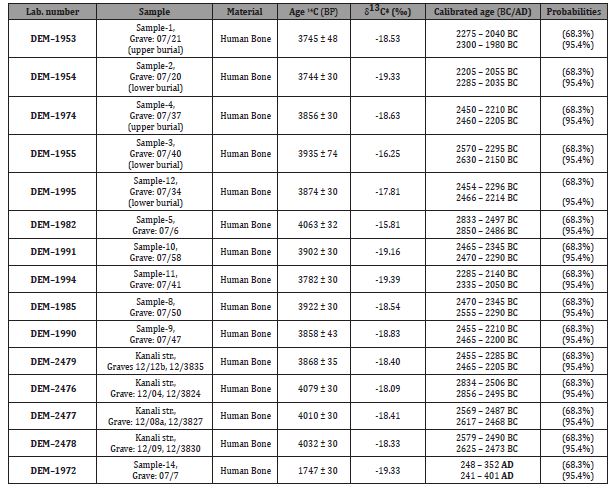


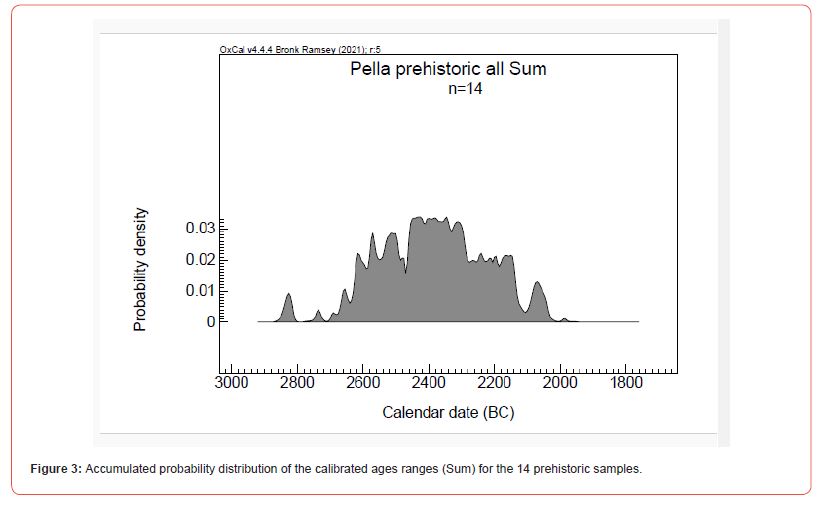
Anthropological data
The anthropological study carried out to record sex and age at death is summarized in Table 2. In most cases the sex and age of individuals were determined with relative certainty. Cases where the appropriate diagnostic features were not present are indicated with question marks or blanks. In these cases, sex and age are presented with reservations. In any case, the confident or less confident results are enough to establish that all ages and sexes are represented in the sample of both cemeteries.
As it is shown in Table 2 out of the 30 individuals examined and sampled 16 were male, 12 female and 2 children. Oral hygiene was observed and recorded in half of the examined skeletons (15 out of 30 individuals) because only in these teeth were preserved. Of these 15 skeletons that preserved teeth, 10 belonged to the Classical Period (CP) and one to the Byzantine Period and only 4 to the EBA. It is difficult to draw statistical conclusions about oral hygiene due to the small number of samples. It is with great caution that we formulate some overall conclusions which are somewhat more reliable for the Classical period where specimens with dental evidence are somewhat more numerous. These conclusions can be summarized as follows:
I. Caries in Classical Pella appears in at least one tooth in 4 out of 10 people, percentage 40%, while in the EBA in 1 out of 4, percentage 25%.
II. Calculus in Classic Pella appears in 6 out of 10 people, a percentage of 60%, while in EBA in 2 out of 4, percentage 50%.
III. Periodontitis in Classic Pella occurs in 8 out of 10 people, percentage 80%, while in EBA in 3 out of 4, percentage 75%.
IV. Finally, the sample from the Byzantine period shows caries, calculus and periodontitis.
Although the occurrence of dental diseases is multifactorial and can be influenced by genetic predisposition and demographic parameters, diet is a dominant factor. It is known from the literature (Lieverse [18]) that foods rich in protein facilitate the creation of plaque and, by extension, dental calculus, while carbohydrates are related to caries. Based on these, it can be tentatively concluded that the diet in CP was richer in carbohydrates than that in EBA, since at CP there are more caries incidents than in EBA. In addition, the increased calculus in CP (more incidences than caries) indicates that the diet was also quite rich in protein, relatively richer than in the EBA.
The phenomenon of reduced consumption of starchy foods and carbohydrates has been observed in several populations of the Neolithic and Early Bronze Age in Macedonia (Triantaphyllou [19]), where caries occurrence rates are clearly less than those with calculus. This phenomenon is reversed from the Late Bronze Age onwards (Triantaphyllou [20]), where the consumption of carbohydrates increases rapidly with the result that dental caries prevails over calculus. In the case of Classical Pella, we observe a clear increase in caries in relation to EBA, but without a decrease in calculus but rather an increase in it. This means that the increased consumption of starchy foods and carbohydrates in the CP was accompanied by an increased consumption of protein-rich, more pro- cessed foods that favored the greater occurrence of dental diseases and the generally worse image of the oral hygiene of the population.
Stable isotopes
The values of the stable isotopic ratios (δ13C and δ15N) are presented in Table 2. They represent the average values of 3 different measurements from each sample. The atomic C/N ratio also given in Table 2 ranges from 3.21 to 3.36 for all the samples, except one (PEL 29). These values all lie within the accepted standards 2.9- 3.6 (DeNiro [20]; Ambrose [13]; Harbeck and Grupe 2009; Cheung et al. [21]) suggesting that the collagen in the bones was well preserved and the isotopic results are absolutely safe. The value of PEL 29 (4.04‰) is out of the range and may indicate a certain degree of diagenesis. The isotopic results of this sample should be treated with caution. Figure 4 shows graphically the distribution of isotopic values of the samples from the two cemeteries and the Byzantine period burial inside the prehistoric cemetery.
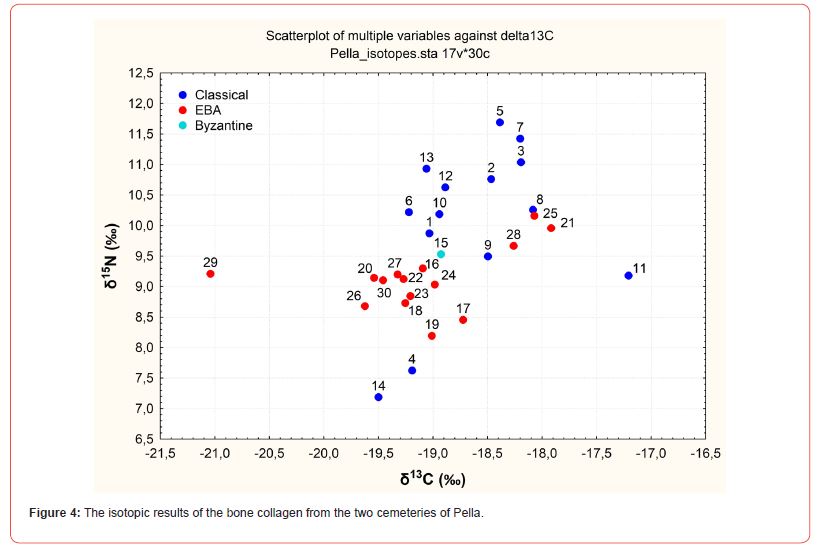
Table 2: Anthropological examination and isotopic results.
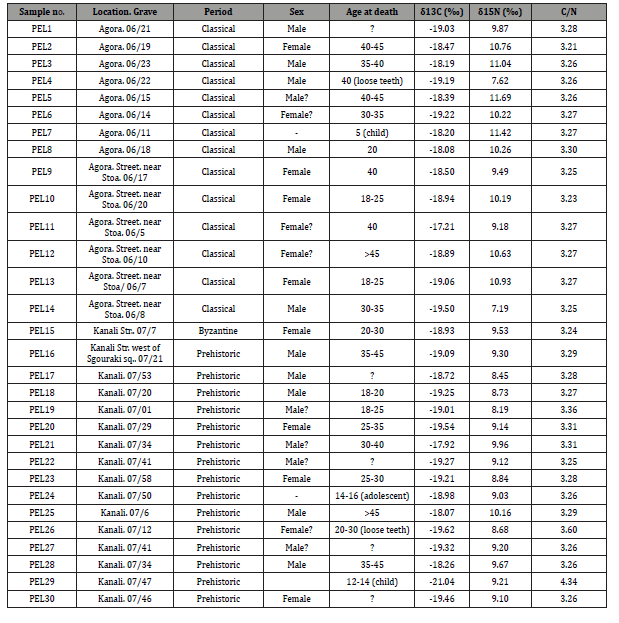
From this figure one notices that the isotopic values of the Classical Period individuals are generally more elevated in δ15N and slightly in δ13C than those of the EBA period, which indicates that the diet during the CP was more enriched in animal protein, mainly from terrestrial environment. This result partially agrees with the findings of higher calculus. There are some exceptions to this rule with three individuals showing a clearly differentiated diet compared to the majority of individuals from both cemeteries. In particular, two individuals of CP (PEL 4 and 14, men around 40 years and 30-35 old respectively) show δ15N values lower than all the rest which, combined with the low δ13C, indicates a diet mainly based on plants (C3) and with a very low input of animal protein. In contrast, the individual PEL11 (an elderly woman) has an isotopic signal suggestive of C4-type plants (millet) since it has relatively increased δ13C without a corresponding increase in δ15N. Most likely this woman had a percentage of consumption of meat from animals fed on millet, unless she consumed directly a certain amount of the millet plant, rather unusual.
Regarding the EBA burials, the isotopic concentrations of the majority of individuals agree with those from Xeropigado Koiladas cemetery in West Macedonia (Triantaphyllou 2010), dating to the EBA and MBA (Maniatis and Ziota [22]) and other sites of Late Neolithic and EBA in North Greece (Triantaphyllou [19]) and elsewhere in Greece (Papathanasiou [23]), and indicate a diet based on terrestrial plants and animals. The individuals PEL-21, 25 and 28, all male, most probably had a slightly increased animal protein diet compared to the rest or/and a very small percentage of marine food. Sample PEL-29, a child aged 12-14 years, deviates strongly form all the rest exhibiting a much lower δ13C value (-21.04‰) without an equivalent drop in δ15N. This could be a child with health problems and starvation (Ingvarsson-Sundstrom et al. 2009) which probably led to its death in this young age. On the other hand, the deviation in the δ13C value of this specific sample may be due to a relative degree of diagenesis and certain incorporation of inorganic carbon into its collagen from the soil. This is possibly indicated by the somewhat increased ratio of C/N in relation to all the rest (Table 2).
It is interesting to note that both in the Prehistoric and Classical Periods, the diet of the people in Pella does not seem to include a distinct percentage of marine food, even though it is known that the area was coastal in antiquity. Even in the Classical period where fishing techniques had improved significantly, the inhabitants of Pella did not resort to the sea to enrich their diet in proteins but enriched it with proteins from land animals possibly with the intensification of animal husbandry.
Regarding the relationship between sex and diet, we can extract some information from the statistical distribution of the data using Box Plots for δ13C and δ15N (Figures 5 and 6). These plots show the distribution of the δ13C and δ15N values for the two cemeteries and for men, women, children and the adolescent separately. Keeping in mind that the data is not statistically big enough for secure conclusions we can tentatively deduce that the values of δ13C (Figure 5) remain the same between men and women in the CP both for the individuals whose sex has been determined with relative certainty and those with a question mark. However, a certain differentiation is observed in the EBA where δ13C seems lower in securely identified women and the one with question mark, perhaps indicating a difference in nutrition between the two sexes. On the other hand, the values of δ15N do not show any obvious difference between men and women (Figure 6). The generally lower values of the isotopes, mainly δ13C in the women of the EBA probably indicate a diet based more on plant foods and less on animal proteins than men at the same time. This differentiation between the two sexes in Prehistoric Pella is the opposite of that which has been observed in Asine of the MBA (Ingvarsson-Sundstrom et al. [24]).
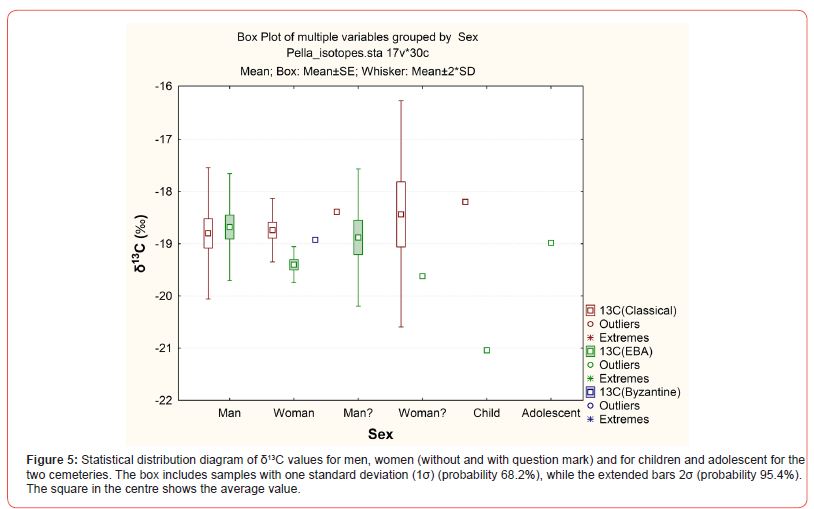
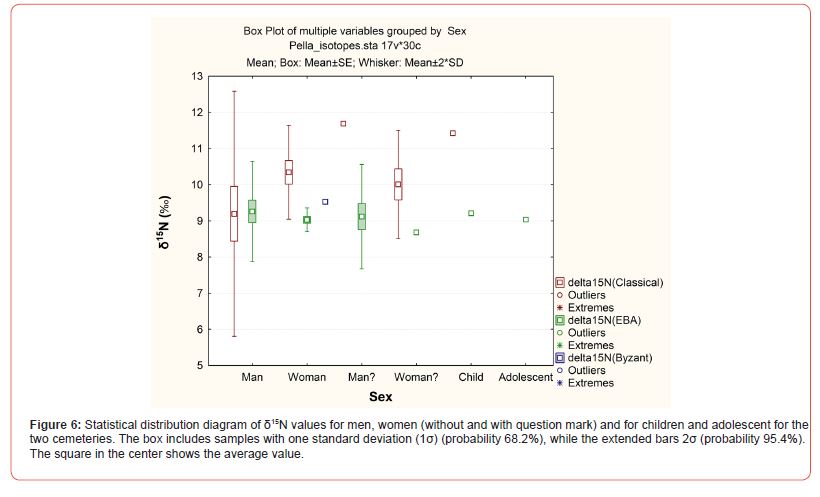
Regarding the Classical period, a difference in nitrogen appears to occur between men and women, with women tending to have on average higher values than men (Figure 6). However, since the number of samples is small, the distribution of male values is strongly influenced by the two samples PEL-4 and 14 that have a particularly low nitrogen diet (Figure 4) and both happen to be male. If one removes these two samples, it follows that the average value of δ15N of all the other samples of the CP is over 10‰, which brings the Box plot to the same level as that of the women of the classical era and all higher than the EBA. With these data and always with the caveat of the small statistical sample, we consider that there is no difference in nutrition between men and women in Classical Pella, which indicates an improvement in the role of women and/or wealth in general and, consequently, easier access to nutritional sources, perhaps also through increased livestock production.
As for the children for whom we have only two samples, one in CP and one in EBA, we notice that the diet of the Classical period child is clearly more enriched in animal proteins than the diet of the EBA child. And the only adolescent of EBA has approximately the diet of adult men of the time. The values of δ15N in herbivore animals, including cattle and pig is more or less the same from prehistoric to classical and later periods in North Greece (Triantaphyllou [19]) and for different periods in Thebes (Vika [25]) and ranges mostly around 6‰.
Therefore, assuming that this value of δ15N represents the diachronic fauna isotopic concentration, the diet of men and women in the CP is enriched in δ15N over the fauna by around 4‰ (from about 6‰ to about 10‰). If we take the highest reasonable value for enrichment of human collagen over diet to be 5‰ (Hedges and Reynard [26]), a value of 4‰ enrichment implies that at least 80% of the dietary protein of the CP population was from animals (as meat + milk), accepting that freshwater fish need not be considered as significant (Hedges and Reynard [26]).
Conclusion
Skeletal material from the Classical cemetery at Pella and the Prehistoric cemetery found under the Hellenistic Pella were anthropologically examined, analyzed isotopically and the burials from the prehistoric cemetery were also radiocarbon dated. The radiocarbon dates show that the prehistoric cemetery was used in the period approximately 6600-6050 BC, which corresponds to the middle and lower half of the Early Bronze Age. Inside the EBA cemetery a grave was discovered dating in the Byzantine/Early Christian period.
The anthropological and dental study of the skeletal material from the two cemeteries gave interesting insights about the eating habits and access to food sources in the two periods. The people of the Classical period seem to consume mostly foods enriched in animal protein (meat and dairy products) from the terrestrial environment as evidenced by the increase mainly in δ15N and not particularly δ13C. This result is also strengthened by the examination of oral hygiene, which is recorded as worse than their EBA predecessors, possibly due to an increased consumption of dairy foods, proteins, but also starchy foods and carbohydrates. The increased consumption of animal proteins during the Classical Period in Pella agrees with corresponding results from Thebes (Vika [25]). An explanation for this may be the use of fertilizers as population growth forced more efficient exploitation of the environment and improved animal husbandry.
An increase in the consumption of animal protein during the Classical period has also been observed in the region of Sparta in Peloponnese (unpublished Laboratory of Archaeometry data) but with a parallel increase in the percentage of sea food, a fact that is not observed in the region of Pella. With regard to the two sexes, a small differentiation is observed in EBA where the diet of women can be considered, with reservation due to the small statistical sample, as less enriched in animal proteins. This can be expected when there are distinct social roles (such as men’s participation in particularly hard physical work or even wars). On the contrary, in the Classical Period, there is no difference in nutrition between the two sexes that points to improved socio-economic conditions. However, it is noted that due to the small statistical sample, the conclusions for the two sexes both from the isotopes and from the teeth must be used with caution.
Finally, the effect of millet is observed in the isotope values of one person, possibly a woman, either through the consumption of animals fed with millet or directly of the plant.
Acknowledgments
We would like to sincerely thank professor Emeritus Ioannis Akamatis of Aristotle University of Thessaloniki for giving us the opportunity to examine and analyze the skeletal material from both cemeteries at Pella and providing every possible help for carrying out this project.
Conflict of Interest
No conflict interest.
References
- Lilimbaki-Akamati M, Akamatis I M, Chrysostomou A, Chrysostomou P (2011) The Arcaheological Museum of Pella John S Latsis Public Benefit Foundation ed. OLKOS.
- Akamatis, IM (2011a) Pella, In Brill’s Companion to Ancient Macedon. Studies in the Archaeology and History of Macedon 650 BC-300 AD (ed. Lane Fox) Brill, Boston-Leiden, pp.393-408.
- Akamatis, IM (2011c) The Cemetery in the Agora District. In the Archaeological Museum of Pella John S Latsis Public Benefit Foundation ed OLKOS. Vol. 40-54.
- Akamatis, IM (2011b) The Bronze Age Cemetery. In the Archaeological Museum of Pella John S Latsis Public Benefit Foundation ed. OLKOS, 35-39.
- Bronk Ramsey C (2021) Oxcal v4 4 4 calibration program.
- Ambrose, S H, Krigbaum J (2003) Bone chemistry and bioarchaeology. Journal of Anthropological Archaeology 22(3): 193-199.
- Van Der Merwe N J, Vogel J (1978) 13C Content of human collagen as a measure of prehistoric diet in woodland North America. Nature 276(5690): 815-816.
- Howland MR, Corr LT , Young, SMM, Jones V, et al. (2003) Expression of the dietary isotope signal in the compound-specific δ13C values of pig bone lipids and amino acids. International Journal of Osteoarchaeology 13(1-2): 54-65.
- Müldner G, Richards M P (2005) Fast or feast: reconstructing diet in later medieval England by stable isotope analysis. Journal of Archaeological Science 32(1): 39-48.
- Schoeninger M J, DeNiro M J (1984) Nitrogen and carbon isotopic composition of bone collagen from marine and terrestrial animals. Geochimica et Cosmochimica Acta 48(4): 625-639.
- Valamoti SM (2002) Investigating the Prehistoric Bread of Northern Greece. The archaeobotanical evidence for the Neolithic and the Bronze Age; Civilisations (online) 49: 49-66.
- Cheung C, Schroeder H, Hedges R E M (2012) Diet, social differentiation and cultural change in Roman Britain: new isotopic evidence from Gloucestershire. Archaeological and Anthropological Sciences 4(1): 61-73.
- Ambrose, S H (1990) Preparation and characterization of bone and tooth collagen for isotopic analysis. Journal of Archaeological Science 17(4): 431-451.
- Petroutsa E (2007) Meléti tis diatrofís se plithysmoús tis Elládas tis epochís tou chalkoú, PhD thesis, Department of Biology, University of Athens, Athens.
- Triantaphyllou S (2010) Aspects of Life Histories from the Bronze Age Cemetery at Xeropigado Koiladas. Western Macedonia, In MESOHELLADIKA, Actes du colloque international organisé par l’École française d’Athènes, en collaboration avec l’American School of Classical Studies at Athens et le Netherlands Institute in Athens, Athènes, 8-12 mars 2006 In: (Eds.), A Philippa Touchais, G Touchais, S Voutsaki, and J Wright, pp.969-74.
- Maniatis Y, Oberlin C, Tsirtsoni Z (2016) 'BALKANS 4000’: The Radiocarbon dates from archaeological contexts. In The human face of radiocarbon (ed. Z. Tsirtsoni) Maison de l’Orient et de la Méditerranée, Lyon. TMO 69: 41-65.
- Arvaniti T, Maniatis Y (2018) Tracing the absolute time-frame of the Early Bronze Age in the Aegean. Radiocarbon 60(3): 751-773.
- Lieverse A R (1999) Diet and the aetiology of dental calculus. International Journal of Osteoarchaeology 9(4): 219-232.
- Triantaphyllou S (2015) Stable Isotope Analysis of Skeletal Assemblages from Prehistoric Northern Greece. In Archaeodiet in the Greek World: Dietary Reconstruction from Stable Isotope Analysis In: (Eds) A Papathanasiou, M Richards, and S Fox), pp. 57-75.
- DeNiroMJ (1985) Postmortem preservation and alteration of in vivo bone collagen isotope ratios in relation to palaeodietary reconstruction. Nature 317(6040): 806-809.
- Harbeck M, Grupe G (2009) Experimental chemical degradation compared to natural diagenetic alteration of collagen: implications for collagen quality indicators for stable isotope analysis. Archaeological and Anthropological Sciences 1(1): 43-57.
- Maniatis Y, Ziota C (2011) Systematic radiocarbon dating of a unique Early and Middle Bronze Age cemetery at Xeropigado Koiladas. West Macedonia, Greece, Radiocarbon 53(3): 461-487.
- Papathanasiou A (2015) Stable Isotop e Analyses in Neolithic and Bronze Age Greece: An Overview, In Archaeodiet in the Greek world. Dietary Reconstruction from Stable Isotope Analysis Hesperia supplement In (Eds): A Papathanasiou, MP Richards, and S Fox Hesperia supplement 49, The American School of Classical Studies at Athens, Athens 3: 25-55.
- Ingvarsson-Sundstrom A, Richards M P, Voutsaki S (2009) Stable isotope analysis of the middle Helladic population from two cemeteries at asine: Barbouna and the east cemetery. Mediterranean Archaeology and Archaeometry 9(2): 1-14.
- Vika E (2011) Diachronic dietary reconstructions in ancient Thebes, Greece: results from stable isotope analyses. Journal of Archaeological Science 38(5): 1157-1163.
- Hedges R E M, Reynard L M (2007) Nitrogen isotopes and the trophic level of humans in archaeology. Journal of Archaeological Science 34(8): 1240-1251.
-
M Maniati, Th Pitsios and Y Maniatis*. Investigation of the Human Diet in Pella (North Greece) from the Prehistoric to the Classical Period Using Stable Isotopes and Radiocarbon Dating. Open Access J Arch & Anthropol. 5(2): 2023. OAJAA.MS.ID.000606.
-
Demokritos, Archaeometry, lyophilizer, Radiocarbon, Carbohydrates, Neolithic
-

This work is licensed under a Creative Commons Attribution-NonCommercial 4.0 International License.






